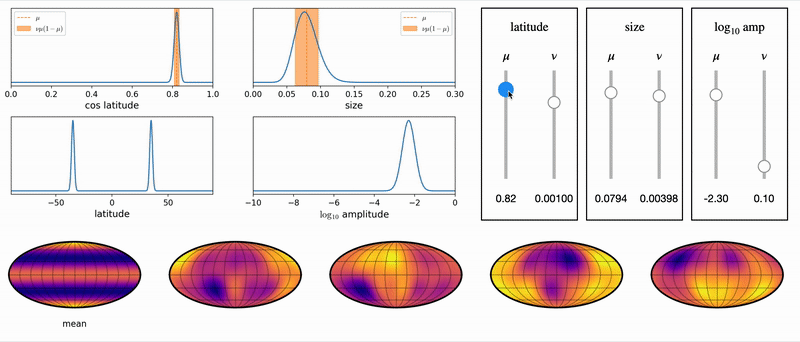
This week’s group meeting was a bit quieter than usual, but we still had some useful discussions.
Rodrigo Luger started us off with a discussion of a Gaussian Process kernel for light curves he has derived, using starry, that is parameterized by interpretable physical parameters of the target star’s surface: rotation period, inclination, active latitude, spot size, and spot contrast ratio. This is exciting because, while Gaussian Processes are often used to infer the properties of stars from their light curves, the models currently used are all phenomenological. Rodrigo has created an interactive widget (see the header image) to demonstrate, qualitatively, how the parameters of the GP model relate to the implied surface map. There was some discussion (and disagreement) about whether or not a physically motivated model like this could improve current planet detection methods (using light curves or radial velocities) either by increasing the sensitivity of these searches or by improving the reliability of the results.
Next, David W. Hogg updated us on an ongoing project with Megan Bedell and Lily Zhao (Yale) to improve the wavelength calibration of extreme precision radial velocity spectrographs (in particular, EXPRES). They have developed a data-driven method to identify a low-dimensional representation of the wavelength solution residuals that can be used to substantially improve the (already outrageously good) wavelength precision, but now they are looking to interpret this low-dimensional space (a risky endeavour, I would say). In particular, they have found that one factor that seems to correlate with their top principle component is the “vertical position” of the spectrum on the detector. However, there are some inconsistencies between how this effect manifests in the science spectrum and the laser frequency comb spectrum that they have not yet figured out. There was some discussion about whether or not this could be caused by different light paths, but Hogg is skeptical that that is the cause.
Finally, Christina Hedges led a discussion about tips and tricks that we have all learned from working remotely. Many members of the group lamented the lack of “random encounters” that happen when we’re all working in the same building, but there were some useful workarounds that people have found. For example, some smaller sub-groups have been doing regular “stand-up” meetings to help accountability and to help keep track of what other group members are working on. This solution, however, does not generally include the same diversity of voices that random encounters in the halls of Flatiron would. There was a discussion about the possibility of having an open video chat that stays open all day, giving people the opportunity to chat and ask questions of whatever group is there at some particular time.